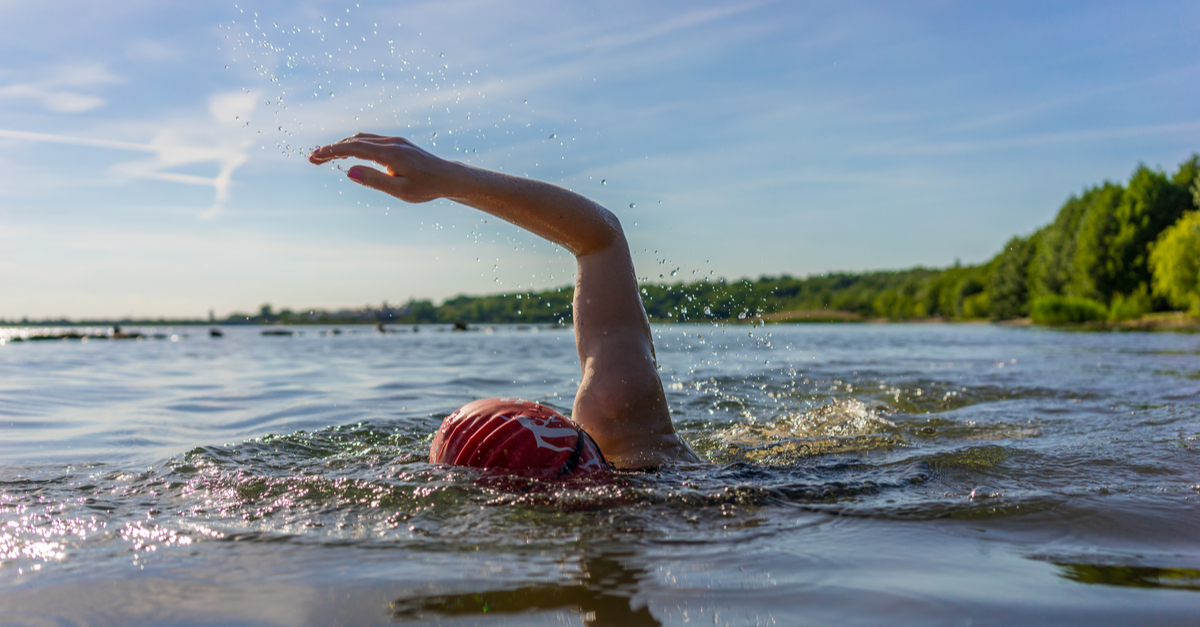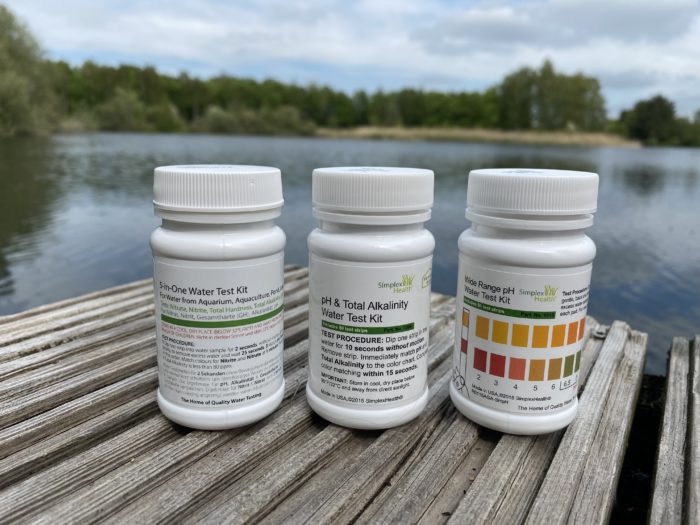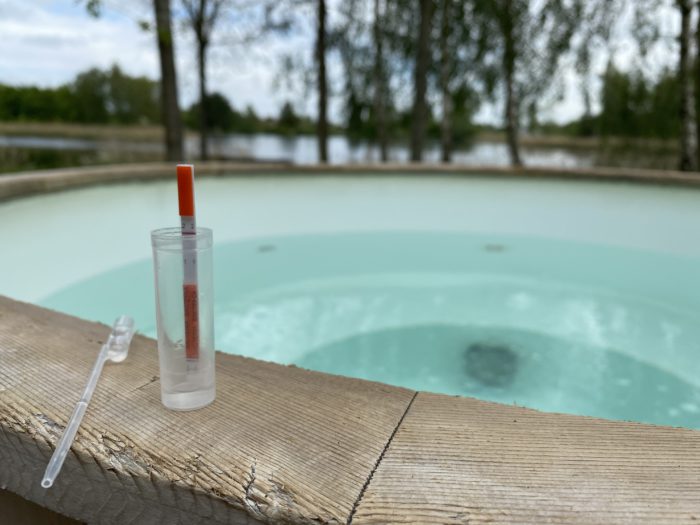 There is always a greater risk of infection or illness caused by microorganisms when swimming in open water (lakes, rivers etc) compared to a chemically treated swimming pool. This guide aims to help identify most appropriate water quality monitoring and testing (*For full details please refer to the guidelines published by the relevant authorities/bodies – our recommendations below can not replace consultation of guidelines issued by local authorities and bodies). Sewage pumped into rivers and seas by water companies can cause illness and feeling of being unwell. Germs can be carried into water by heavy rain. Swimmers can fall sick as microorganisms enter the body via a cut or a splash in the face. Common illnesses include gastroenteritis, ear, nose & throat infections, skin & urinary tract infections. A bacteria test can detect sewage / faecal bacteria in water – for details see below under ‘Recommended Tests’.
There is always a greater risk of infection or illness caused by microorganisms when swimming in open water (lakes, rivers etc) compared to a chemically treated swimming pool. This guide aims to help identify most appropriate water quality monitoring and testing (*For full details please refer to the guidelines published by the relevant authorities/bodies – our recommendations below can not replace consultation of guidelines issued by local authorities and bodies). Sewage pumped into rivers and seas by water companies can cause illness and feeling of being unwell. Germs can be carried into water by heavy rain. Swimmers can fall sick as microorganisms enter the body via a cut or a splash in the face. Common illnesses include gastroenteritis, ear, nose & throat infections, skin & urinary tract infections. A bacteria test can detect sewage / faecal bacteria in water – for details see below under ‘Recommended Tests’.
Testing open waters is important to make sure that you do not put yourself or others at risk from illnesses.
The EU directive and UK Bathing Water Regulations 1991 & 2013 are aimed primarily at those looking to offer their open water to the general public. Both are however a great source to give an insight into what is deemed acceptable water quality for people to swim in. TriathlonScotland has also published a very useful Guidance on Water Quality for Open Water Events. British Triathlon events are mesured against the EC Bathing Water Directive 2006/7/EC and the BTF requirement is that the Excellent threshold is met.
Below you find a general summary of the guidelines in the United Kingdom (UK), which follows similar guidelines to the EU. In addition to this, please make sure that you always check your local guidelines to make sure that everyone is safe. If you plan to open your water to the general public you must strictly adhere to the guidelines set by the UK.
How often should I check the water: It is recommended to check the quality of the water regularly, ideally at the start of the bathing season, every 2-4 weeks, before any event, when there are visible changes to the water, after heavy rainfall as well as at the end of the bathing season. The pH should be monitored more often as it can be an early indicator of changes, because it is affected by algal and weed growth, agricultural run-off as well as waste water from industry.
How many water samples should I take and where should I collect them: This varies depending on the water body, its size and the purpose of the testing. It is recommended to take the water samples from the part of the water body which is used for swimming, specially the entry points. If the swimming area is large you might want to take a number of samples across the different parts of the water. You might also decide to take additional samples at inlets, specially if they are from farmland/ agricultural land.
How to take a water sample: With the exception of algal blooms, samples should be taken 30cm below the water surface and in water which is at least 1m deep. Samples should be transported as soon as possible after collection in a cool box (we provide a cool box as well as ice packs) so that they arrive at the laboratory within 24 hours. Bacteria samples are to be taken using a sterile bottle. To avoid accidental contamination, the sampler is to employ an aseptic technique (there is no further need for sterile equipment such as gloves if this is done properly).
The water quality is generally classed as excellent, good, sufficient or poor – based on the number of colony forming units per 100ml (cfu/100ml). Swimming should not take place in poor quality water.
| Parameter | Value Maximum |
|---|---|
| Total Coliforms (cfu/100ml) | low (no further details provided) |
| Escherichia Coli (E.coli) (cfu/100ml)* | Inland Waters: excellent: <500, good: <1000, sufficient: <900, poor (= FAIL): >900
Coastal Waters: excellent: <250, good: <500, sufficient: <500, poor (= FAIL): >500 |
| Intestinal enterococci (cfu/100ml)* | Inland Waters: excellent: <200, good: <400, sufficient: <330, poor (= FAIL): >330
Coastal Waters: excellent: <100, good: <200, sufficient: <185, poor (= FAIL): >185 |
| pH | 6 to 9 |
| Blue-green algae (cells/ml)** | If visible bloom, count should be carried out; low: <20,000; moderate: >20,000 – <100,000; high (= FAIL): >100,000 |
| Conductivity | The purer the water the lower the conductivity |
| Appearance | No abnormal change in colour |
| Odour | None |
| Transparency | >1 metre |
| Surfactants | No lasting foam |
| Mineral Oils | No surface film or odour |
| Phenols | No phenolic odour |
*For irregular and one-off tests, the standards for excellent / sufficient / poor are considered most approriate. The rating of good should be looked at for regular testing where the results are averaged out.
**Please note, that not all species of blue-green algae are toxic and further investigation may be advisable where moderate levels are recorded. The Environment Agency provides species-specific values which should be looked at.
Recommended Tests for Open Water Swimming:
Laboratory Tests: to test water for public use, a laboratory test is recommended. The results of the bacteria laboratory test are presented in cfu/100ml (cfu=colony forming units). With each lab test a test report is issued. Here is a selection of relevant tests:
- Bacteria Tests: Coliform/E.coli, or Coliform/E.coli & Enterococci
- 4 tests in One: Coliform/E.coli, Enterococci, pH, conductivity
- 5 tests in One: Coliform/E.coli, Enterococci, pH, Conductivity, Cyanobacteria (blue-green algae)
- Conductivity Water Test
- Cyanobacteria/ blue-green Algae
All our laboratory tests are suitable to check brackish/salty sea water. For the full range of laboratory tests, please click here. If you are planning on carrying out various or regular tests, then please contact us for a specific quote.
Field/Home Screening Tests for fresh water: field test kits provide instant results (these are suitable for fresh water only and are screening tests). Below is a selection of products:

- Pool & Spa Bacteria Test Strips – Detection level: 1000 cfu/ml, 10 tests per pack
- 15 Minute Bacteria Test Strips – Detects coliform and non-coliform bacteria at 10³ cfu/ml, 2 tests per pack
- pH 2-12, pH 5.5-9, pH & Total Alkalinity
- 5-in-One to test pH, Total Alkalinity, Nitrate, Nitrite and Total Hardness (these test strips can be used for fresh as well as salt water)
- Nitrate/Nitrite – this is particularly important if your open water is on or near farmland
- Total Metals to measure the amount of dissolved metals in water
Field/Home Screening Tests for sea/brackish water: field test kits which provide instant results
- Field/Home Screening Teststrips: 5-in-One to test pH, Total Alkalinity, Nitrate, Nitrite and Total Hardness (these test strips can be used for fresh as well as salt water)
- Photometer: For regular self testing we can recommend the photometer test marine/salt water iDip 570 Photometer for marine/salt water.
Swimming Pools & Spas: These guidelines are designed to give general information about regulations for open water swimming, this includes lakes, rivers etc. Different recommendations exist for swimming pools & spas – please refer to separate guidelines for these. Click here for our wide range of test strips for Pools & Spas. The iDip photometer Pool & Spa is ideal for regular testing of public pools and commcercial use. For more information about how to look after your hot tub safely and test the water regularly, click here.

Further Free Resources:
Got a question about water testing? Try our complete list of Free Water Testing Resources. Here are the most frequently read guides:
- Click here to download our FREE Water Guide
- Read an overview of the potential contaminants in your water
- Why test your water and water supply?
- Unusual colours, smells and taste of your water & further advice on finding the right test kit
- How to choose the right Water Testing Kit
- Choosing the right water testing kit for a water improvement & purification system, water cooler or a pool, spa or hot tub
- How to understand the results of your Quality Water Test Kit
- How to test for lead correctly and what immediate steps can be taken to reduce lead exposure
- How to get the best drinking water – which water filter?
- How to check if my water filter is working?
- How to test the pH of soap?
- How to find the source of a leak in a property
- How to measure the pH of water & other liquids correctly
- How to look after your hot tub safely and test the water regularly
- What is best pH level for drinking water? How to measure the pH of water & other liquids correctly
- How to test the quality of Open Water for bathing or swimming
- Commercial Applications for Water Testing: Buyers Guide – Water Testing on vessels, ships as well as water tanks in remote locations
If you can’t find what you are looking for then please contact us, as we can source many other test kits. Discounts for bulk purchases available, please contact us to find out more.
Disclaimer: All guidelines and recommendations accurate at time of publishing. Please check current regional / local guidelines relevant to your situation. We can not be held responsible for any information published on this webpage. The limits provided are for guidance only, we do not provide compliance statements. If the results are being used for compliance to a specific requirement or standard, then please use this for reference. Only opinions based upon our own personal experience or information available in the public domain is cited. This has been done exclusively for anyone who is interested in this subject but is not intended to replace proper research & analysis. We cannot accept responsibility and liability of any kind which may result from the application of this information. We always recommend to consult an expert to discuss any test results or get a full recommendation on the specific subject and specific to your situation by an expert. We also recommend to check if there is any newer or later information on this subject.
This information is owned by SimplexHealth and you do NOT have the right to reprint, sell, auction or distribute this information.
